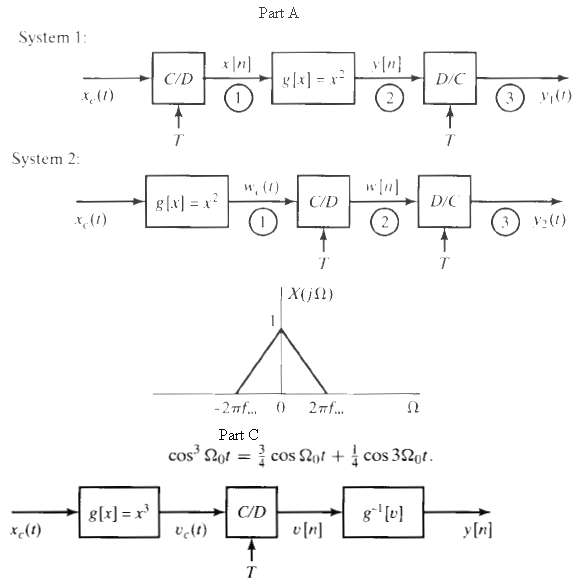This problem explores the effect of interchanging the order of two operations on a signal, namely, sampling
Question:
This problem explores the effect of interchanging the order of two operations on a signal, namely, sampling and performing a memoryless nonlinear operation.
(a) Consider the two signal-processing systems in Figure, where the C/D and D/C converters are ideal. The mapping g[x] = x2 represents a memoryless nonlinear device.?
For the two systems in the figure, sketch the signal spectra at points 1, 2, and 3 when the sampling rate is selected to be 1/T = 2 fm Hz and xc(t) has the Fourier transform shown in Figure. Is y1(t) = y2(t)? If not, why not? Is y1(t) = x2(t)? Explain your answer.

(b) Consider system 1, and let x(t) = A cos (30?t). Let the sampling rate be 1/T = 40 Hz. Is y1(t) = x2c(t)? Explain why or why not.?
(c) Consider the signal-processing system shown in Figure, where g[x] = x3 and g?1[v] is the (unique) inverse, i.e., g?1[g(x)] = x. Let x(t) = A cos (30?t) and 1/T = 40 Hz. Express v[n] in terms of x[n]. Is there spectral aliasing? Express y[n] in terms of x[n]. What conclusion can you reach from this example? You may find the following identity helpful:
(d) One practical problem is that of digitizing a signal having a large dynamic range. Suppose we compress the dynamic range by passing the signal through a memoryless nonlinear device prior to A/D conversion and then expand it back after A/D converter in our choice of the sampling rate?
Step by Step Answer:

Discrete Time Signal Processing
ISBN: 978-0137549207
2nd Edition
Authors: Alan V. Oppenheim, Rolan W. Schafer





